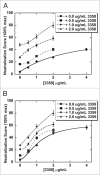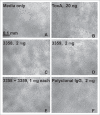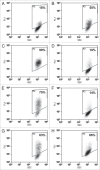Neutralization of Clostridium difficile toxin A using antibody combinations
- PMID: 20150758
- PMCID: PMC2840238
- DOI: 10.4161/mabs.2.2.11220
Neutralization of Clostridium difficile toxin A using antibody combinations
Abstract
The pathogenicity of Clostridium difficile (C. difficile) is mediated by the release of two toxins, A and B. Both toxins contain large clusters of repeats known as cell wall binding (CWB) domains responsible for binding epithelial cell surfaces. Several murine monoclonal antibodies were generated against the CWB domain of toxin A and screened for their ability to neutralize the toxin individually and in combination. Three antibodies capable of neutralizing toxin A all recognized multiple sites on toxin A, suggesting that the extent of surface coverage may contribute to neutralization. Combination of two noncompeting antibodies, denoted 3358 and 3359, enhanced toxin A neutralization over saturating levels of single antibodies. Antibody 3358 increased the level of detectable CWB domain on the surface of cells, while 3359 inhibited CWB domain cell surface association. These results suggest that antibody combinations that cover a broader epitope space on the CWB repeat domains of toxin A (and potentially toxin B) and utilize multiple mechanisms to reduce toxin internalization may provide enhanced protection against C. difficile-associated diarrhea.
Figures




Similar articles
-
Immunization with Bacillus spores expressing toxin A peptide repeats protects against infection with Clostridium difficile strains producing toxins A and B.Infect Immun. 2011 Jun;79(6):2295-302. doi: 10.1128/IAI.00130-11. Epub 2011 Apr 11. Infect Immun. 2011. PMID: 21482682 Free PMC article.
-
Novel Clostridium difficile Anti-Toxin (TcdA and TcdB) Humanized Monoclonal Antibodies Demonstrate In Vitro Neutralization across a Broad Spectrum of Clinical Strains and In Vivo Potency in a Hamster Spore Challenge Model.PLoS One. 2016 Jun 23;11(6):e0157970. doi: 10.1371/journal.pone.0157970. eCollection 2016. PLoS One. 2016. PMID: 27336843 Free PMC article.
-
Toxin-specific antibodies for the treatment of Clostridium difficile: current status and future perspectives.Toxins (Basel). 2010 May;2(5):998-1018. doi: 10.3390/toxins2050998. Epub 2010 May 7. Toxins (Basel). 2010. PMID: 22069622 Free PMC article. Review.
-
A novel multivalent, single-domain antibody targeting TcdA and TcdB prevents fulminant Clostridium difficile infection in mice.J Infect Dis. 2014 Sep 15;210(6):964-72. doi: 10.1093/infdis/jiu196. Epub 2014 Mar 27. J Infect Dis. 2014. PMID: 24683195 Free PMC article.
-
Clostridium difficile infection in 2010: advances in pathogenesis, diagnosis and management of CDI.Nat Rev Gastroenterol Hepatol. 2011 Feb;8(2):67-8. doi: 10.1038/nrgastro.2010.215. Nat Rev Gastroenterol Hepatol. 2011. PMID: 21293502 Review.
Cited by
-
Monoclonal antibodies specific for Bacteroides fragilis enterotoxins BFT1 and BFT2 and their use in immunoassays.PLoS One. 2017 Mar 3;12(3):e0173128. doi: 10.1371/journal.pone.0173128. eCollection 2017. PLoS One. 2017. PMID: 28257448 Free PMC article.
-
Protection against Clostridium difficile infection with broadly neutralizing antitoxin monoclonal antibodies.J Infect Dis. 2012 Sep 1;206(5):706-13. doi: 10.1093/infdis/jis416. Epub 2012 Jun 25. J Infect Dis. 2012. PMID: 22732923 Free PMC article.
-
Neutralization of Clostridium difficile toxin A with single-domain antibodies targeting the cell receptor binding domain.J Biol Chem. 2011 Mar 18;286(11):8961-76. doi: 10.1074/jbc.M110.198754. Epub 2011 Jan 7. J Biol Chem. 2011. PMID: 21216961 Free PMC article.
-
Development and characterization of phage display-derived anti-toxin antibodies neutralizing TcdA and TcdB of Clostridioides difficile.Microbiol Spectr. 2023 Sep 5;11(5):e0531022. doi: 10.1128/spectrum.05310-22. Online ahead of print. Microbiol Spectr. 2023. PMID: 37668373 Free PMC article.
-
The repetitive oligopeptide sequences modulate cytopathic potency but are not crucial for cellular uptake of Clostridium difficile toxin A.PLoS One. 2011 Mar 18;6(3):e17623. doi: 10.1371/journal.pone.0017623. PLoS One. 2011. PMID: 21445253 Free PMC article.
References
-
- Kyne L, Farrell RJ, Kelly CP. Clostridium difficile. Gastroenterol Clin North Am. 2001;30:753–777. - PubMed
-
- Mylonakis E, Ryan ET, Calderwood SB. Clostridium difficile-associated diarrhea. Arch Int Med. 2001;161:525–533. - PubMed
-
- Pothoulakis C, LaMont JT. Microbes and microbial toxins: paradigms for microbial mucosal interactions II. The integrated response of the intestine to Clostridium difficile toxins. Am J Physiol Gastrointest Liver Physiol. 2001;280:178–183. - PubMed
-
- Kuijper EJ, Coignard B, Tull P. Emergence of Clostridium difficile-associated disease in North Americ and Europe. Clin Microbiol Infect. 2008;12:2–18. - PubMed
MeSH terms
Substances
LinkOut - more resources
Full Text Sources
Other Literature Sources
Medical
